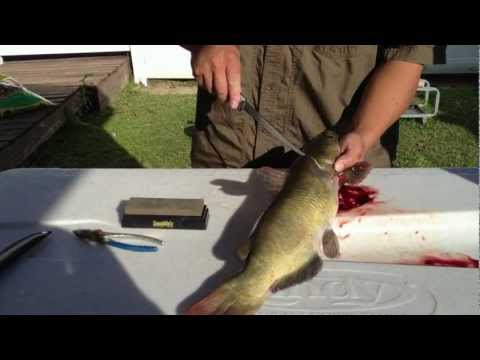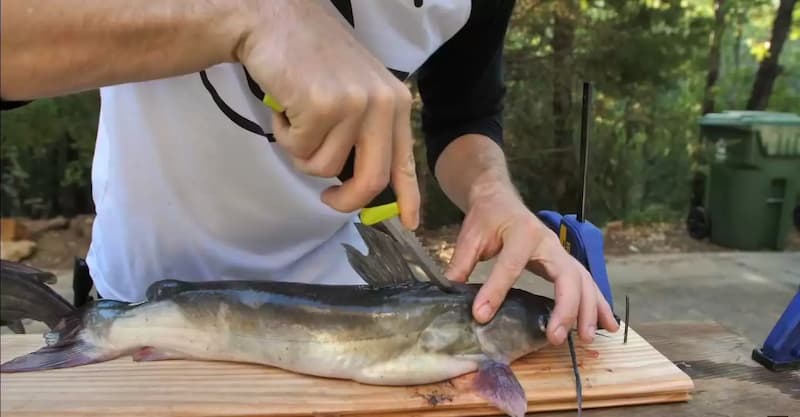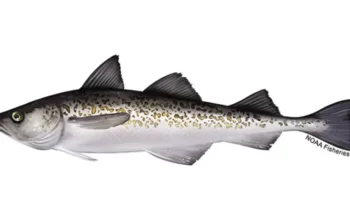Catfish have tough, leathery skin that can be difficult to eat if left on the flesh. Whether you’re preparing your catch or store-bought fish, you can peel and clean it at home with some common household tools. Here’s an easy-to-follow guide on how to properly clean catfish.
Table of Contents
What You Need
Here are the items you need:
1. Long cutting board
2. Sharp corner knife
3. A bowl of water
4. Trash can
5. Catfish (2 pounds and above are best)
6. Wire shears or pruning shears
Steps To Clean A Catfish

Here’s a step-by-step approach that fishermen have used for generations:
1. Lay the catfish flat on the abdomen. You will notice the pectoral fins on the sides, just behind the gills, and sticking out straight. These fins have the barbs that catfish are notorious for. The spines make it difficult for the catfish to lay flat on one side. Use wire cutters to cut them flush to the side of the catfish.
2. Next, lay the catfish on its side with its belly facing away from the body. Locate the bones that extend from the back of the pectoral fins to the back of the fish. You will notice a place where the bone stops and the tender meat starts. In the soft meat just past the bone, cut a diagonal line from the top of the head, sloping slightly towards the back of the fish.
3. Flip the catfish and repeat on the other side. Find where the bones stop and the meat starts. Then, make a diagonal cut, but stop when you hit the spine.
4. Now we will go down the top of the fish. Try to feel the spine and place the knife between the spine and the flesh. You need to stay on one side of the dorsal fin. In the first few inches, your knife can only penetrate so far. The ribcage will prevent you from going through the fish completely.
5. Once you go through the ribs, you will find that the knife penetrates easily. Turn the fish over. Run the knife all the way through the fish, as close to the spine as possible. The tip of the knife will go through the bottom of the stomach. Walk your way to the tail, but don’t cut the skin once you get to the tail. Remember to keep the knife at an angle to the fish or you will waste the meat.
6. Flip the catfish over to the belly. Starting at the top of the head, spread the meat away from the spine. Run your fillet knife between the rib and the meat. Don’t worry if this takes some work. Once you’ve cut through the ribs, cut along the spine all the way to the belly of the catfish. When done, you should have a fleshy flap supported only by the skin of the tail.
7. Flip the side of the catfish over and fold the skin/meat over the tail. Tilt the knife down towards the tail – just between the skin and the meat – until the meat is completely cut from the skin. You should check the fillets for missing bones. If there is any omission, please delete it.
8. Some catfish have a very thin lateral line/mud vein that runs the length of the fillet. Trim or cut. If there is a layer of fat on top of the fillet, trim it off and you’re done. Put the fillets into a bowl or bucket of cold water.
9. Now, we need to repeat it on the other side.
10. Lay the catfish on its stomach, along the spine, around the dorsal fin, and down to the end of the ribs.
11. With the fish on its side, slide the knife all the way in. Then, follow the ribs all the way to the tail.
12. Place the fish on the belly, around the ribs, and all the way to the belly.
13. Place the fish on its side and turn the meat flaps over. Cut and trim the meat from the skin. Throw the fillets in the bucket and you’re done.
An Advanced Method For Cleaning Catfish
There are many ways to clean catfish, including the method used by experienced catfish anglers, which involves using an electric knife or sharp blade to cut the skin off the fish without actually skinning the catfish.
When used correctly, an electric knife or a sharp blade produces a beautiful piece of boneless meat. However, this method may require more skill and finesse.
This method leaves the angler with a nice fillet that includes a rib cage that can be easily removed with a knife.
So, no matter which method you choose, you’re sure to have delicious catfish meat to add to your next fry!
Conclusion
Like many rituals, cleaning your first catfish can be a messy ordeal. You’ll soon learn that this proven method will produce catfish fillets without the need for gut or skin catfish. Of course, the more catfish you clean, the easier it will be. The most rewarding part of getting the job done was the catfish plate at the end.




